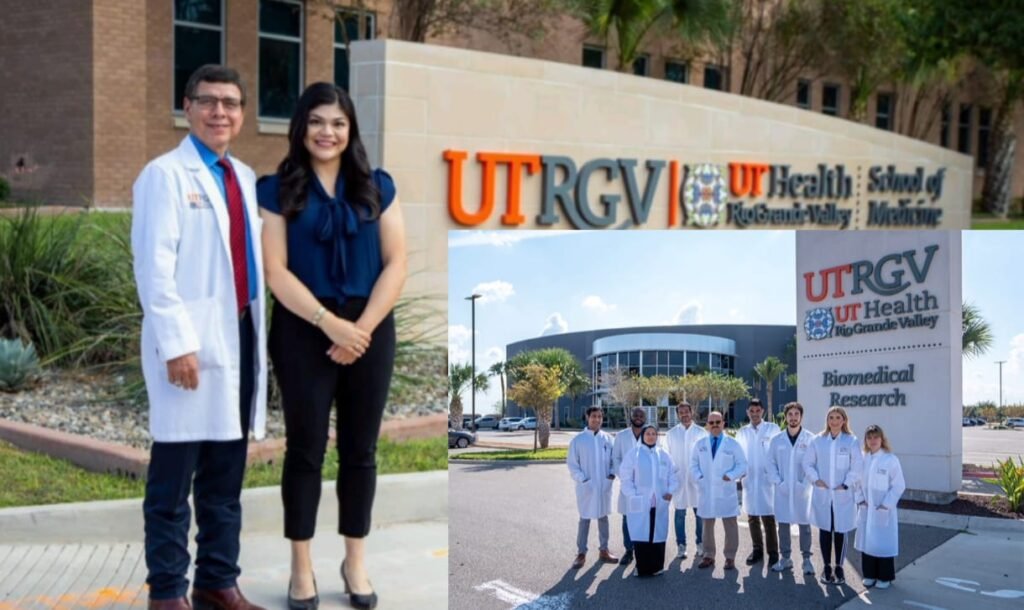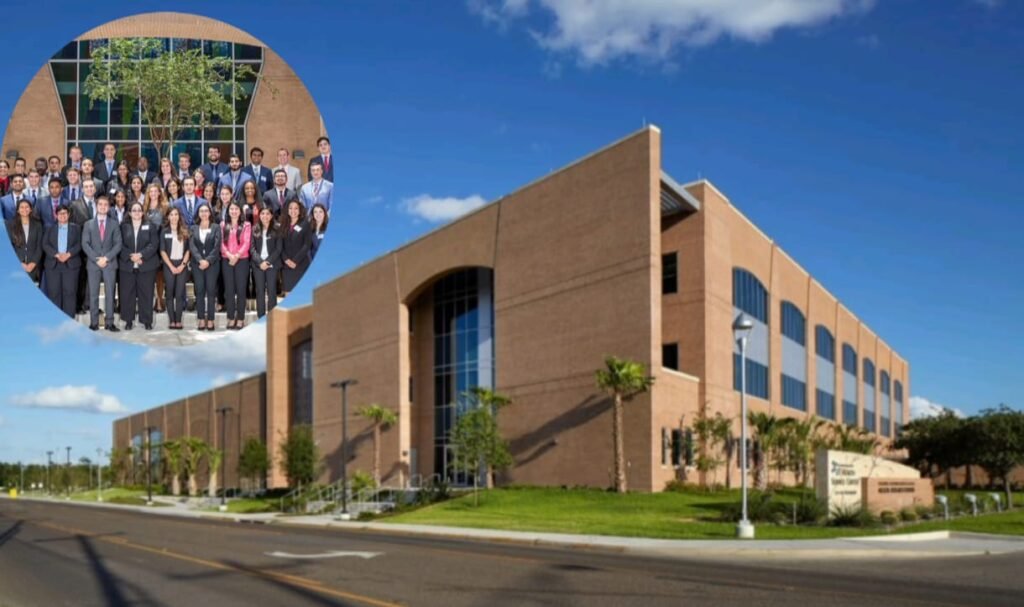UT Rio Grande Valley School of Medicine: How to Get Admission in 2025 – Full Details
Introduction
In the realm of medical education, few institutions have risen as quickly and meaningfully as the UT Rio Grande Valley School of Medicine. Founded in the heart of South Texas, this innovative school addresses one of the United States’ most critical healthcare deserts.
The school’s mission is not just about training medical professionals — it’s about equipping socially conscious leaders in medicine who are prepared to serve underserved populations.
What distinguishes the UT Rio Grande Valley School of Medicine is its dedication to culturally competent care, its location in a region deeply in need of physicians, and its futuristic, tech-enabled curriculum.

The institution acts as a bridge between traditional medical education and the future of holistic, community-focused health systems.
With an acceptance rate lower than 2%, the school is already a top choice for candidates who value impact-driven careers. Its affiliation with the University of Texas System and robust research programs has attracted students, faculty, and grants from across the nation.
Establishment and Vision
The establishment of the UT Rio Grande Valley School of Medicine was more than a state-level initiative — it was a regional revolution. Officially approved in 2013 by the Texas Legislature, the school’s founding signaled a renewed commitment to accessible, world-class healthcare in the Rio Grande Valley, one of America’s most underserved areas.
Before the school’s founding, patients in South Texas often had to travel hundreds of miles for specialized care. With the creation of the UT Rio Grande Valley School of Medicine, this began to change.
The school’s vision was bold: create a pipeline of bilingual, community-sensitive doctors who would not only stay in the region but also revolutionize its health outcomes.
The school embraces a student-centered learning model, integrating simulation, service, and scientific inquiry at every stage. With a vision focused on equity, ethics, and innovation, it’s quickly becoming a model for medical schools nationwide.
Campus and Infrastructure
Spread across multiple cities — Edinburg, Harlingen, Brownsville — the infrastructure of the UT Rio Grande Valley School of Medicine mirrors its regional commitment. Each facility is purpose-built for a specific component of the medical curriculum, allowing immersive learning from day one.
The Simulation Hospital in Harlingen is a 15,000-square-foot, high-fidelity training ground where students face real-life medical scenarios through virtual patients, robotic manikins, and mock surgeries.
Students at the UT Rio Grande Valley School of Medicine engage in these simulations to sharpen diagnostic, communication, and procedural skills — long before their clinical rotations begin.
Also notable is the school’s plastination lab — the largest in the U.S. — which gives students a unique hands-on approach to human anatomy. Libraries are fully digital, with access to thousands of journals, e-books, and clinical databases.
Each campus is designed to be accessible, sustainable, and collaborative. Whether students are learning cardiology in Edinburg or serving patients in rural McAllen, the infrastructure empowers them every step of the way.
Academic Programs Offered
The UT Rio Grande Valley School of Medicine offers more than just a Doctor of Medicine (MD). It presents students with a range of dual-degree options and academic experiences that combine public health, ethics, and technology into one transformative journey.
Key Programs:
MD Program: A 4-year, integrated course blending basic sciences with early clinical exposure.
MD/MPH: For students interested in policy, epidemiology, and community health initiatives.
MD/MS in Bioethics: Designed for ethically aware physicians who may work in administration, law, or international health.
MD/MS in Biomedical Informatics: A futuristic offering focused on data science, AI, and clinical decision systems.
Beyond degrees, students can participate in the Summer Research Fellowship, Rural Health Immersion Program, and Global Health tracks. These programs enhance clinical reasoning and provide opportunities for publishing peer-reviewed research.
Each academic pathway at the UT Rio Grande Valley School of Medicine is rooted in relevance — ensuring students graduate not only as doctors but as visionaries.
MD Curriculum Structure
The MD program at the UT Rio Grande Valley School of Medicine is designed to be rigorous, patient-centered, and community-engaged. It spans four years and is divided into three main phases:
Phase 1: Foundations of Medicine
This 18–21 month phase covers basic sciences, anatomy, physiology, pharmacology, pathology, and ethics. A major strength of this phase is Early Clinical Exposure—students start interacting with standardized patients, working in simulated environments, and developing basic history-taking and physical exam skills.
Phase 2: Clerkships
Students rotate through Internal Medicine, Surgery, Pediatrics, OB/GYN, Psychiatry, and Family Medicine. These hands-on rotations take place in various UT Health RGV clinics and regional hospitals, ensuring exposure to diverse cases.
Phase 3: Advanced Clinical Training
Final-year students choose electives, sub-internships, and specialty rotations. A special “Capstone Course” prepares them for residency, combining clinical assessments, mock interviews, and ethical reasoning scenarios.
The UT Rio Grande Valley School of Medicine ensures students not only pass USMLE exams but also graduate as confident, community-conscious physicians.
Dual Degree Options
To meet evolving demands in medicine, the UT Rio Grande Valley School of Medicine offers powerful dual-degree combinations:
MD/MS in Bioethics
Students explore moral complexities in clinical practice, organ transplantation, end-of-life care, and public health policy.
MD/MPH (Public Health)
Ideal for students who want to engage in epidemiology, disease prevention, health promotion, and policy-making.
MD/MS in Biomedical Informatics
With the explosion of medical data, this program helps students master analytics, artificial intelligence in diagnostics, and EMR systems.
These programs make UT Rio Grande Valley School of Medicine students stand out in residency applications and leadership roles.
Admission Requirements
Admission to the UT Rio Grande Valley School of Medicine is competitive. To be considered, candidates must meet the following:
U.S. Citizenship or Permanent Residency
Bachelor’s Degree with strong science coursework
MCAT score ≥ 500 (with 122+ in all sections)
Science GPA ≥ 3.2 (overall GPA ≥ 3.5 preferred)
Strong personal statement
Minimum of 2 letters of recommendation (one from science faculty)
Clinical, volunteer, and research experience
Applications are submitted via TMDSAS, and selected applicants are invited for Multiple Mini Interviews (MMIs).
The UT Rio Grande Valley School of Medicine values well-rounded applicants committed to service and healthcare equity.
Application Process
The application process is structured in three key stages:
1. Primary Application (TMDSAS): Includes biographical data, coursework, personal statement, and activities.
2. Secondary Application (UTRGV-SOM): Includes targeted essays assessing applicants’ alignment with the school’s mission.
3. Interview Invitation: Shortlisted candidates undergo MMIs or traditional interviews.
The admissions committee evaluates academic metrics and life experiences equally.
UT Rio Grande Valley School of Medicine uses a rolling admissions process, so early applicants get a higher chance of consideration.
Student Profile & Selection Criteria
Each incoming class at the UT Rio Grande Valley School of Medicine consists of approximately 50 students. While GPA and MCAT are important, the admissions team looks at:
Leadership roles
Service to underserved populations
Spanish language proficiency (a big plus!)
Cultural competence
Research experience
In 2024, nearly 4,000 applicants applied for 50 seats—making the acceptance rate around 1.25%.

Fees and Financial Aid
The UT Rio Grande Valley School of Medicine is among the most affordable in the U.S.
In-State Tuition: Approx. $20,000/year
Out-of-State: ~$34,000/year
Living Costs: ~$15,000/year
Health Insurance & Fees: ~$2,000/year
Financial Aid:
Need-based scholarships
Merit-based awards
Federal Direct Loans
Texas Medical Loan Repayment for rural service
The school offers a dedicated financial services office to guide students through budgeting, repayment, and scholarship opportunities.
Faculty and Research Excellence
The UT Rio Grande Valley School of Medicine employs over 250 full-time faculty, including physician-scientists, ethicists, public health experts, and data scientists.
Key Research Areas:
Genomic Studies (e.g., obesity, diabetes)
Neurodegenerative Diseases
Cancer Biology
Health Disparities in Hispanic Populations
Maternal Health
Students can participate in research early on, publish in peer-reviewed journals, and even present at national conferences.
Clinical Training & Partnerships
Students gain practical skills through:
UT Health RGV Clinics: Over 20 locations in the region
UniMovil: A mobile unit for rural health outreach
Partner Hospitals: Valley Baptist Medical Center, Doctors Hospital Renaissance, and others
Clinical learning begins in the first year — a key advantage of the UT Rio Grande Valley School of Medicine’s approach to integrated education.
Community Outreach & Impact
The school has embedded service into its DNA. Students regularly participate in:
Colonias Health Screenings
Diabetes Awareness Camps
Women’s Health Clinics
COVID-19 Vaccination Drives
Disaster Response and Mental Health Support
Through its Area Health Education Centers (AHECs), the UT Rio Grande Valley School of Medicine provides preventive care and education to the neediest populations.
Residency & Career Opportunities
Residency match rates are over 95%, with students going into:
Internal Medicine
Family Medicine
Pediatrics
Psychiatry
Emergency Medicine
OB/GYN
Many choose to stay in the Valley, fulfilling the school’s goal of retaining homegrown talent. The UT Rio Grande Valley School of Medicine also supports early career mentorship, mock interviews, and networking with residency directors.
Student Life & Organizations
Life at the UT Rio Grande Valley School of Medicine goes beyond textbooks. Students can join:
Latino Medical Student Association (LMSA)
Student Government Association (SGA)
Global Health Interest Group
Arts in Medicine
Medical Spanish Club
Regular wellness weeks, fitness challenges, and mental health resources ensure a balanced life.
Achievements & Recognitions
Fully LCME Accredited
100% residency match (Class of 2024)
Multiple NIH-funded research projects
State recognition for rural health outreach
Faculty named among Top 100 U.S. Physicians for Diversity
The UT Rio Grande Valley School of Medicine continues to gain national attention for its bold and inclusive model.
Future Roadmap & Strategic Growth
The school has ambitious plans:
New UT Health Cancer & Surgery Center (2025)
Virtual reality-based anatomy training
Expanding class size to 100 students/year
Launching fellowships in Addiction Psychiatry and Rural Medicine
The UT Rio Grande Valley School of Medicine is actively shaping the future of medical education, one student at a time.
Final Thoughts (Conclusion)
The UT Rio Grande Valley School of Medicine is a revolutionary institution committed to transforming healthcare, not just educating doctors. By placing service, science, and social justice at its core, the school is producing the kind of physicians our world needs.
From innovative curriculum to deep community ties, this is more than a school — it’s a mission. A mission that invites you to be part of the change.


